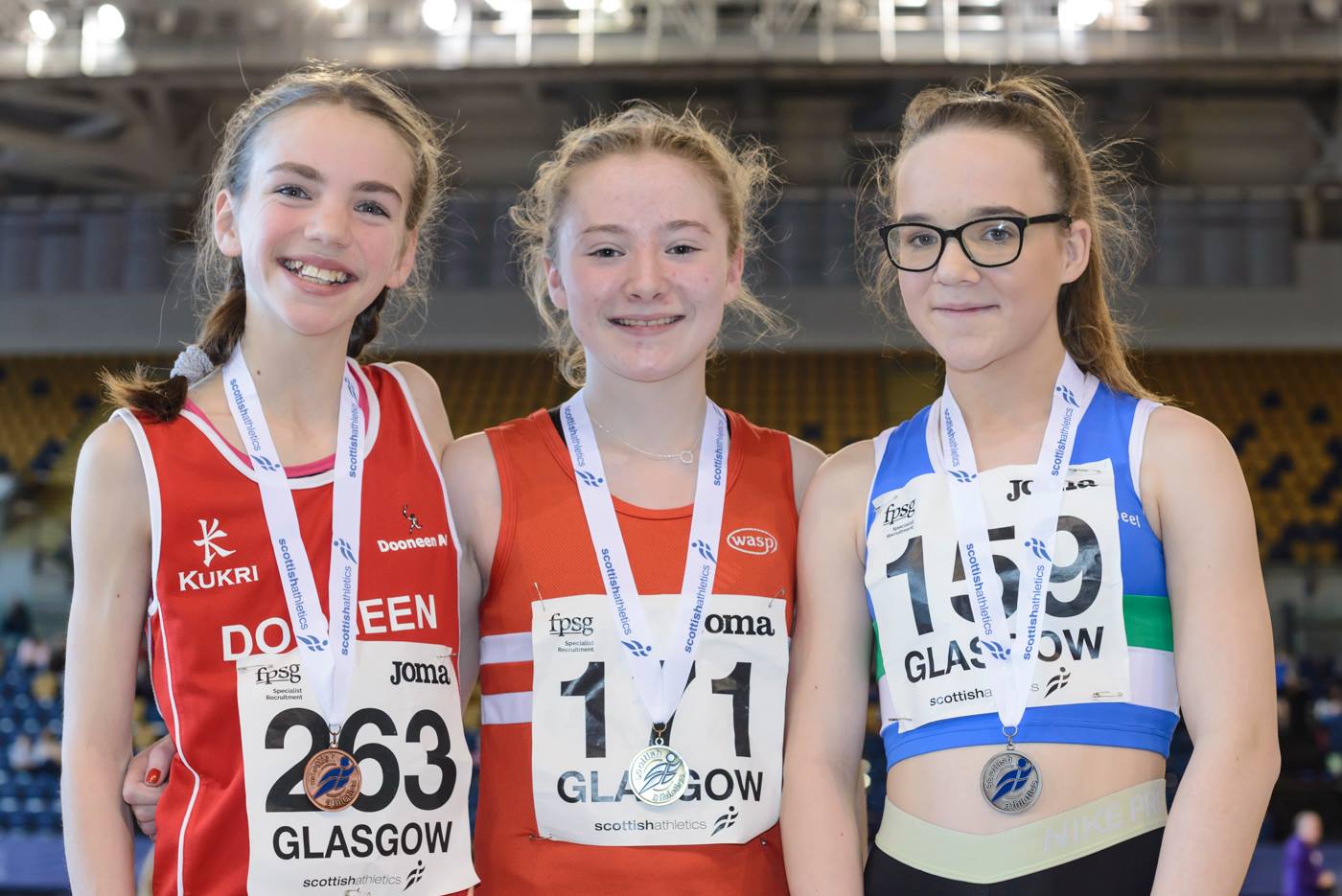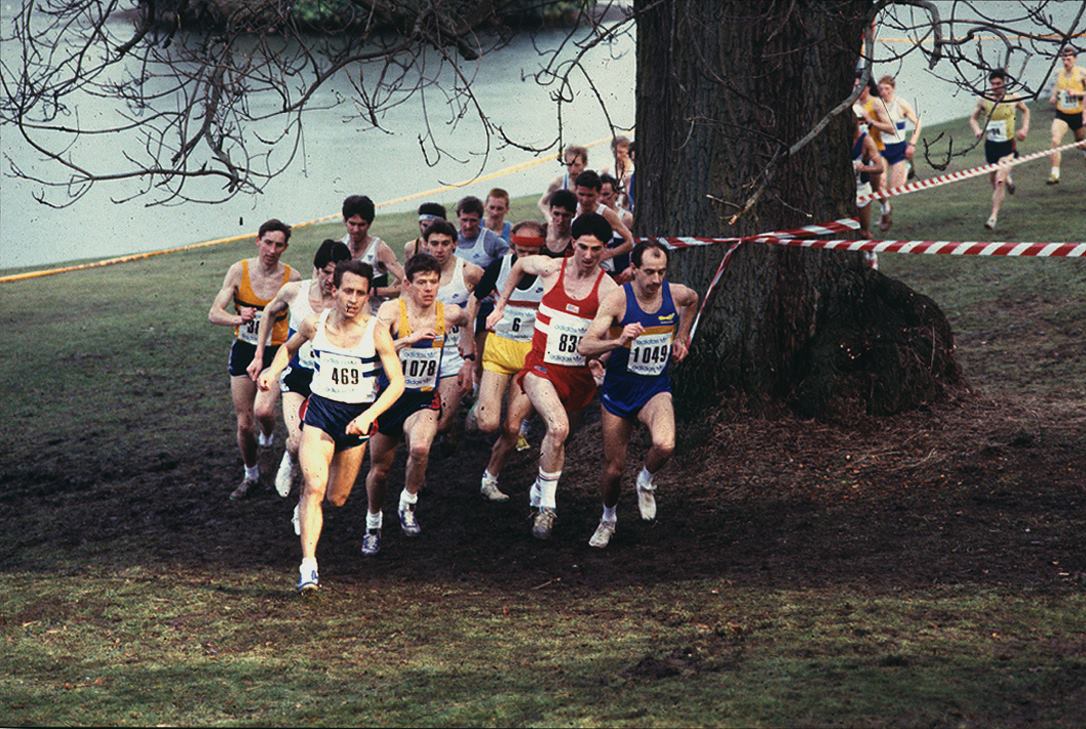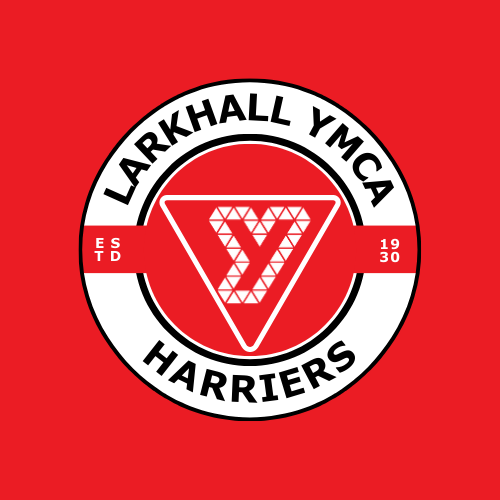
The History of
Larkhall YMCA Harriers
© William Mowbray - May not be copied or reproduced without his express permission.
Media enquiries to mediaofficer@larkhallymcaharriers.org
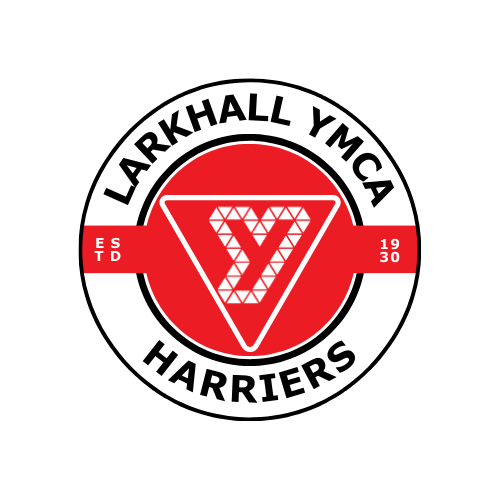
Last updated January 2024
Larkhall YMCA was established in 1897 in the rooms above what is now Semi Chem in Union Street. Early in the 1900s the organization moved to Caledonian Road after buying the land between King Street and the Police Station boundary wall from the Caledonian Railway Company. Shortly after World War One the YMCA sold the building which it had built on this land to two local businessmen, who were also YMCA members, and the YMCA moved into barracks erected on the current site that had been purchased from the Army. The two businessmen then sold the building to the Royal Mail who used it as town’s main post office until the late 1970's. By the 1960s the barracks were in a very poor condition, so the YMCA Board embarked on the fund raising and construction project that produced the modern building, which was completed in 1970.
Over the years, in addition to the main groups currently based in the hall, the YMCA has been used at different times by a wide range of community groups and businesses including the Community Support Group which, until March 2020, had for many years provided programmes for the support and development of adults with learning disabilities, Sunday Schools, a boxing club, a cycling club, Parent and Toddlers, Larkhall Community Council, Blackburn Carpets and Jade’s Florists.
Thirty years after its completion, the building was starting to show its age therefore from 2005 onwards successive Boards have embarked on a number of maintenance and repair programmes, with the aim of prolonging the hall’s useful lifespan. These projects have been successful, although in the not too distant future either substantial investment in the hall may be required or we will need to try and move to new premises to ensure that the YMCA movement maintains its long and proud presence in the town well into the 21st century.
Although this history largely relates to the Harriers, a brief mention of the YMCA hall’s other two remaining long term user groups is useful at this point. They are the Audrey Marshall School of Dance, which runs classes in a variety of dance genres for children aged 4 and over, and the Line Dancers Group which caters mainly for people aged 30 and over. In combination with the Harriers, whose membership is open to anyone 9 and over, the Dancing groups provide a safe environment in which people aged 4 and upwards can learn and develop a range of skills under experienced and/or well qualified coaches/instructors, who encourage and promote physical well being via athletics and dancing.
Until the start of 2020 the combined membership of the three groups – plus the Community Support Group - was approximately 200 and they generated no less than 10,000 attendances per year with over 75% of them comprising of under 18s. However in 2020 the loss of Community Support Group booking, combined with the impact of the Covid 19 pandemic, which closed the building completely for half the year, resulted in a large reduction in memberships and attendances.
The closure was almost certainly the first in our association’s history. As 2022 unfolded we have slowly reversed the decline in attendances as the effects of Covid lessen, but it will probably take several years before we see a return to pre-pandemic membership and attendance numbers. However, although our YM membership continues to be drawn exclusively from the Harriers, the YM hall has been for many years a useful base for other organizations to make a sustained and positive contribution to the physical, social and cultural development of the Larkhall community – especially its youngsters.
Finally, over the last 16 years we have re-established and developed our relationship with YMCA Scotland through our attendance at National Council Meetings and AGMs. The national organization is a federated structure, consisting of 29 autonomous local associations.
Bringing our focus back to the Harriers a rambling club was very active in the town in the 1920s and Richard Campbell, who joined the club at the end of WW2, believed that the Harriers evolved directly from this club. By 1930 the YMCA had an indoor athletic section and that summer the Lanarkshire Association of YMCAs held its Sports Day in Larkhall.
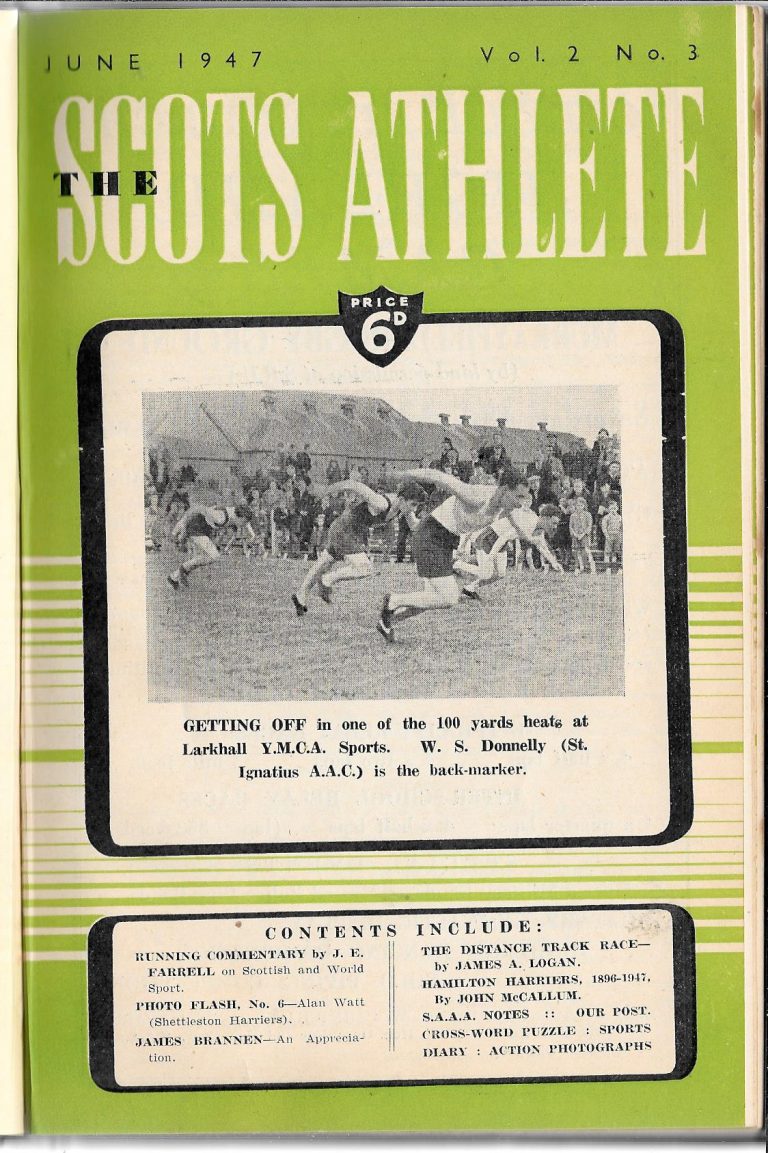
Front cover of "The Scots Athlete" Showing the YMCA Sports held in Larkhall by Larkhall YMCA Harriers in June 1947
Informal committee meetings were being held in 1930 and the club’s first AGM took place in 1931. We know this because they are referred to in a minutes book which dates from April 1933. The stage was set for someone to harness these informal athletics activities, and this person was John C. Scott, an official at Hamilton Harriers.
Under his guiding influence, which was remembered by club members more than twenty years later, Larkhall YMCA Harriers formally came into being in September 1931. The first pack run was held the following month, and the first written records for the club that still survive are dated November 1931 although it should be noted that the club held a 25th anniversary dance in December 1955, as it was generally accepted by the members at this time that club activity dated from 1930.
Following on from this the club’s 60th and 75th anniversaries were celebrated in 1990 and 2005 respectively. Although it had been previously agreed to keep the 2020 90th anniversary celebrations low key the Covid 19 pandemic wiped them out completely. That year, from mid March onwards, our club competitions were either cancelled or considerably altered and for the first time in nearly forty years the annual presentation dance was called off.
Competition outside the club from District level upwards was also either cancelled or drastically curtailed. Our awards ceremony, covering the period October 2020 to September 2021, was eventually held in a scaled down format on the afternoon of February 5th 2022 in the Leisure Centre. The one covering October 2021 to September 2022 was held in Larkhall Bowling Club more or less in the pre-pandemic format although numbers attending were still well down compared to 2019 and earlier.
Interestingly, in the Hamilton Advertiser article that records the formal start of the club, (dated October 1931) the correspondent recalled the previous Harriers Club which existed in the town before the Great War. Although it had no connection to the newly formed YMCA club, its members did perform with distinction during the Edwardian era - especially in 1903 when the club won the Midland Districts Men's Cross Country Championship team title and "reigned supreme in the west".
The most distinguished performer in the club that year was J Crosbie, who finished second in the Midland District event and followed this up a few weeks later with a seventh place finish in the National Cross Country Championships. This latter performance won him a place in the Scottish team which competed in the first ever International CC Championships held at Hamilton Race Course. At this event he excelled himself by being the first Scot home, finishing tenth overall. Therefore Larkhall has the distinction of being the home town of the first Scottish athlete to finish in these championships.
Since its formation in 1930 the Club has nurtured the athletic development and ambitions of successive generations of youngsters from the town and the surrounding area. It has been particularly effective in promoting the social and physical ethos of the YMCA. Moreover, throughout the years its members have become increasingly involved in maintaining the YMCA's presence in the town to the extent that today the Harriers and the YMCA are virtually synonymous in people’s minds.
Club members have performed with distinction at district, inter-district, Scottish, British and International level at various times in the club's history, with these performances in turn being rewarded by selection for inter district squads, Scottish Schools squads, Scottish YMCA squads, Scottish squads and British squads.
Within a few years of it being founded the club had established races, championship programmes and training routines that are clearly recognisable to today’s members. For example, by 1932 the club was staging a Christmas Novelty road race, not only using the handicap and prize giving format still employed to this day, but also running it over much the same course used until 2016.
Due to the poor underfoot conditions at the Green Loan area adjacent to the pedestrian bridge over the M74 the senior course from December 2017 started to use the Keir Hardie Road course. However the event still starts at the Machan Vaults and finishes at St Machan’s Church – although it should be noted the Larkhall Cross to Chatelherault course was used in 2020 in response to the on-going pandemic.
Moreover by the summer of 1933 track scratch and handicap championships were being staged, again establishing a tradition that continues in the club to this day. Indeed that year they used an interesting programme, whereby one week a scratch competition was held for a given distance, followed the next week by its handicap equivalent. This format meant that the combined competitions ran on for the best part of three months - and this method was experimented with again in the 1980's for the scratch championship.
However it was felt that a good deal of the excitement and passion that can be aroused by holding the track championships in a short space of time was lost when employing this format; therefore we changed back to the normal practice of holding them during a 2/3 week window in late August/early September.
In 1935 the track championships were split into three sections: 100 and 220 yards; 440 and 880 yards; 1 and 2 miles. This again is similar to how we run them today for under 17s and upwards; we have a sprints championship run over 100, 200 and 400m, a middle distance championship run over 800, 1500 and 3000, and a field events championship consisting of long jump, shot put and discus. From the winter of 1935 there was also indoor training taking place employing circuit type sessions.
Pack runs were traditionally held on Saturday afternoons – at one time a common practice for Harriers Clubs throughout Scotland. These runs often involved invitations to and from other local clubs such as Hamilton Harriers and Motherwell Harriers. Going hand in hand with these sessions was the Opening Run which was usually held in late September/early October over a combined road and cross country trail that took in Station Road, the old railway line to Ashgill, the right of way that came out on to the A72 about 800 metres south of Shawsburn, the Green Loan right of way that comes out at the top of Keir Hardie Road, and finally down the Machan Brae back to the YMCA.
Both of these traditions survived in our club until the 1980's thanks largely to the efforts of Alex B Perrie, John Mowbray and Richard Campbell. For many years this trio were virtually a Saturday afternoon institution in the town, when they could be seen pounding the town’s streets and local countryside roads and lanes.
They have all passed away; first Alex in 1999 followed by Richard in 2012 and then John in 2015. All three joined the YMCA and YMCA Harriers in the decade following the end of World War Two and their contribution to and involvement in both organizations in numerous capacities over a fifty year period was immense. Finally, the practice of training on Tuesday and Thursday evenings was also established in the decade leading up to the start of the Second World War.
Out with the club, members attended the big athletics events of the time. These included the Novice Cross Country Championships, generally held in November each year, the YMCA Cross Country Championships, held the following month, the Midland District CC Championships usually held in January or February each year, and the National Cross Country Championships which were usually staged in February or March. Again, following a pattern which lasts to the present day, the club's support for these events was sporadic; occasionally a full team would turn out, but more often than not entries were done on a talented individual basis.
From at least 1943 club athletes were also competing in track events held throughout central Scotland each summer, including the Lanarkshire Track Championships and the Scottish YMCA Track Championships. The club first took part in the Scottish YMCA CC Championships in December 1932 at Thornliebank. This was the eleventh annual staging of this event and J.B. Peat from Larkhall was fifteenth in the individual race, with the team finishing eighth overall.
At the 1936 championships Samuel C. Gebbie from Larkhall finished tenth, recording the first top ten placing by a club athlete at a major race out with the club, whilst the club were runners up for the team title. These championships were held at Larkhall for the first time the following year on December 18, when our athletes took full advantage of home ground status by winning the team event for the first time in the club’s short history.
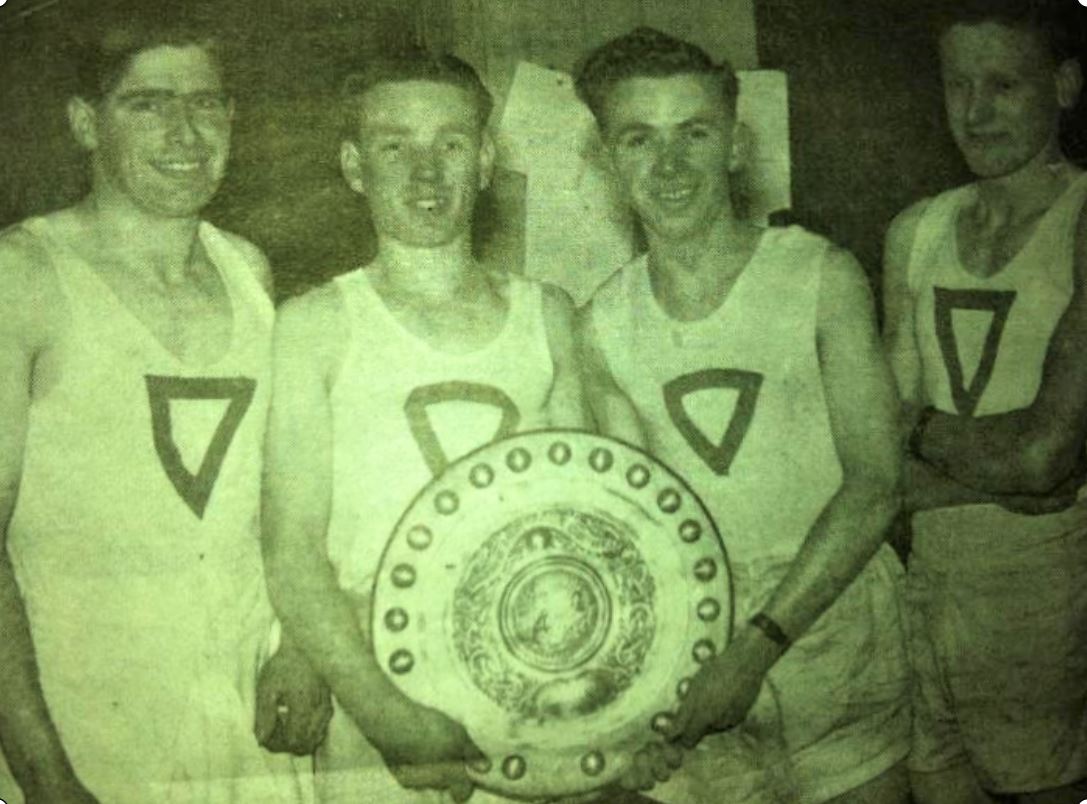
Scottish YMCA CC Champions 1937 J.Gebbie, J.McMillan, William Perrie, and Tom Wedlock
The counting team members were J.Gebbie (3), J.McMillan (4), William Perrie(5), and Tom Wedlock(6). Another fourteen years passed before a Larkhall team repeated this achievement, when a squad consisting of TD Reid, DW Burns, W Hannah and P Corregin triumphed in February 1951, again taking full advantage of the club hosting the championships.
Senior teams also won the SYMCA CC team title in 1971, 1973, 1979 and 1983 with the 1971 title being the only one not won on home ground. In the late 1930s Tom Wedlock was one of our premier performers, carrying on his fine form in the YMCA Championships through to the BUSF Cross Country Championships held at Liverpool in February 1938, where he finished in ninth place whilst representing Glasgow University Hares and Hounds.
The period 1939 - 45 was a tough one for the club, where the major aim of those members exempt from the call up for the war effort, was simply keeping the club in being. From 1939 to 1942 most club and inter club competition was suspended in deference to the titanic events that were unfolding on the world stage. However from September 1942 onwards there was a steady return to something akin to the race programme that had first been established during the 1930s.
Indeed the first club record book dates from November 1942. Inter club pack runs and competition, plus events involving the armed forces became increasingly commonplace in the later war years; and this almost certainly reflects the growing belief in the nation at large that, although the war was proving to be a long and costly one, Great Britain and her allies would be ultimately victorious.
From 1945 to 1950 not only did the club slowly recover much of the character and content that was a feature of the pre-war years, it also looked to broaden its appeal. The club's correspondent Fleetfoot(Jimmy MacFarlane) made a welcome return to the sports pages of the Hamilton Advertiser, although his articles weren't as prolific as those which appeared from 1931 to 1939.
The Ballot Team Races held twice a year, usually in March and December, used the Fairholm Trail for the first time in 1944. August 1949 saw the founding of the first Ladies Section following the receipt of an application for membership by a Miss R.Callen from Lesmahagow. This section had died out by 1952, but was resurrected in various forms in the 1960s and 1970s.
It was an issue which challenged successive generations of male Harriers until it was finally resolved in the late 1980s when the decision was taken to make the club a fully mixed one. Finally, 1948 saw the arrival in the club of David Keir Gracie who, within four short years, was to transform the profile of the club within the Scottish athletics community.
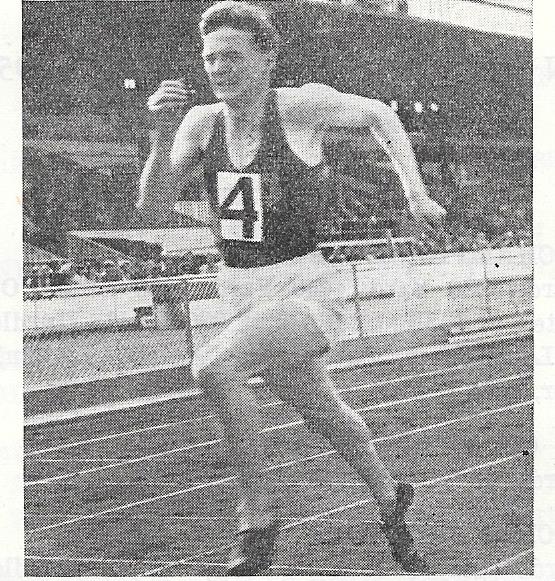
Davie, the club's most distinguished member (January 1927 – October 2020), represented Britain in the 400m hurdles at the 1952 Olympics held in Helsinki. He just missed out on making the final when he finished fourth in his semi-final, being given the same time as the man who finished third. Only 6 athletes progressed to the final, and indeed his fourth place time was better than that of the second place athlete in the other semi-final. Only a few weeks earlier at the White City in London he had beaten John Holland of New Zealand, who went on to win the bronze medal at Helsinki in 52.2 seconds.
Shortly after the Olympics, Davie equalled the twenty year old UK 400m hurdles record of 52.3 seconds. His time stood as the Scottish record for 18 years, and even today - 70 years after it was set - it still stands not far outside the top twenty in the Scottish all time rankings.
In 1953 he won the World University Games 400m Hurdles title in Dortmund, Germany. He was also part of the GB Quartet who won the silver medals in the 4x400m relay at the same event.
Straddling his great years of '52 and '53, he was a seven times SAAA Champion from 1949 to 1954, either over 440 yards or 440 yards hurdles, and in the same period he was also a four times AAA finalist.
He came closest to winning the latter event when he finished third in 1954, only 0.3 of a second behind the winner Harry Kane. However this performance was not considered good enough by the SAAA to merit selection for that year's Empire Games which were held in Vancouver, Canada - a decision which was noted with regret by our President in his report at the 1955 Club AGM.
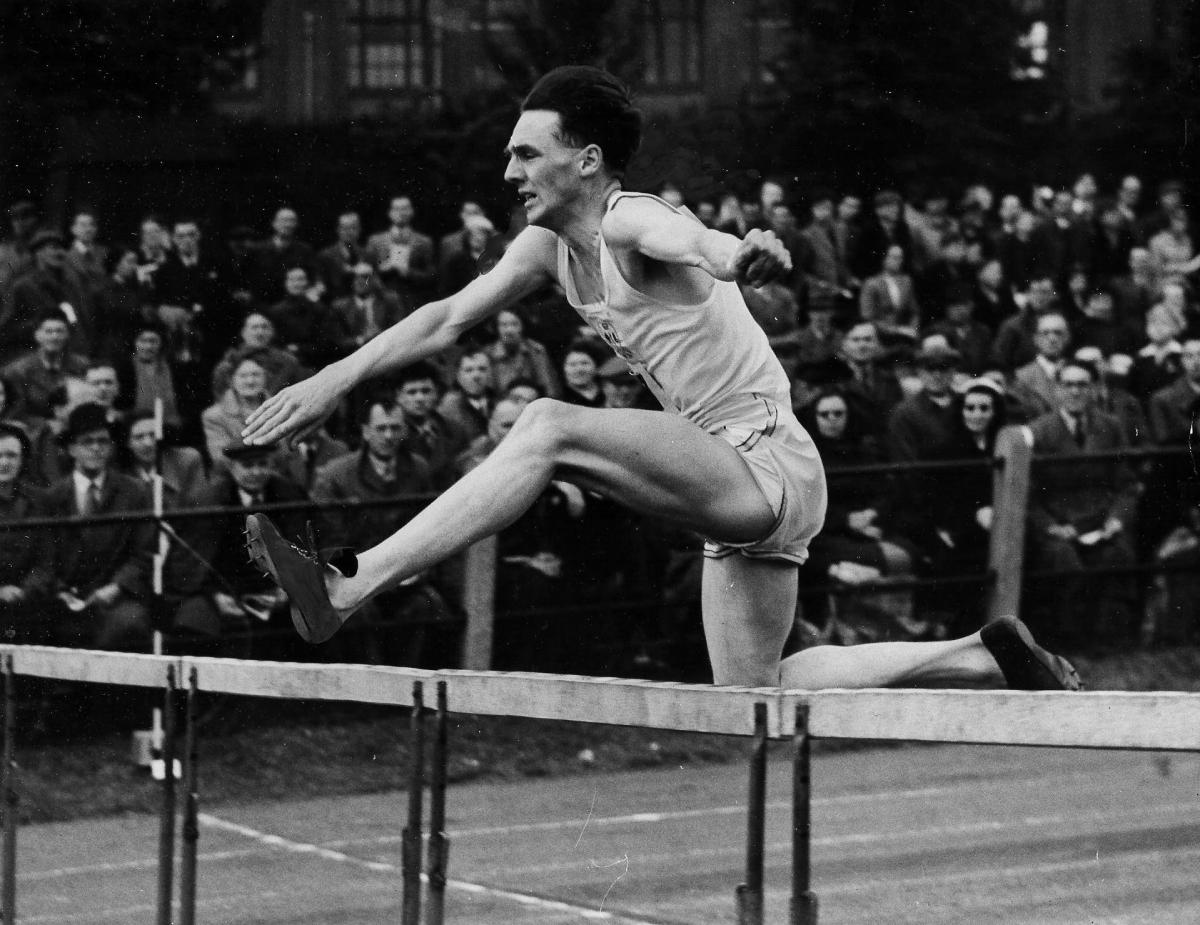
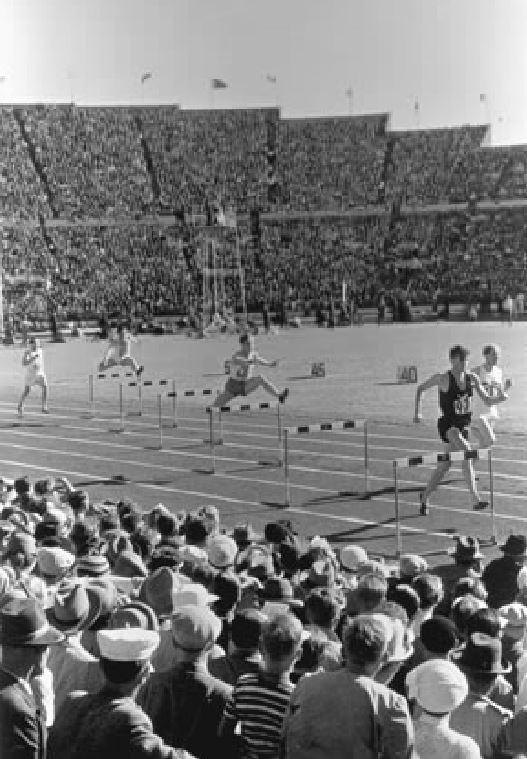
To this day both his 400m flat and 400m hurdles times are club records; the former has been threatened on a few occasions over the years, but the latter has remained out of sight. Until his death in late October 2020 Davie lived with his wife Marion and their daughter Susan in Edinburgh for many years and in October 2019 my wife Fiona and I spent a lovely few hours with them, during which time Davie supplied me with some great information and anecdotes about his time in the Harriers.
For example, his first hurdle was made by a local joiner and fellow club member and he used it in his morning training sessions in Bryce’s Park. After leaving the club in early 1955, when he moved to Kent to take up his first Veterinary post, he was made an Honorary Life Member and he and Marion attended both the 60th and 75th anniversary presentation dances.
Until the end of his life he retained great and fond memories of his years in the club and he was a generous benefactor on several occasions. In the summer of 2017 an article written by Doug Gillon was published in the Sunday Herald, celebrating his career in general and his Olympic adventure specifically.
Davie's achievements, although comfortably the greatest in the club's history, aren't the only ones of merit recorded in the 1950's. For most of the decade Thomas Dempster Reid set new standards in many of the club's road and cross country races. In 1950, after a great performance at the Scottish YMCA CC Championships, he was selected for the Scottish team to take part in the British YMCA Championships held in Manchester.
As mentioned previously, in February 1951 "Dem" was part of the team that won the Scottish YMCA Cross Country Senior Men's Team title for only the second time in the club's history - a performance that earned both him and Des Brown places in the Scottish team for that year's British YMCA CC Championships.
In March 1955, TD Reid and John Stevenson formed part of the Scottish YMCA team that won the British title in Wales, with "Dem", who had been picked as the team captain, finishing in a magnificent 3rd place with John finishing 10th. Des Brown had also been selected for the Scottish team but, unfortunately, he was unable to compete.
That same year TD Reid also became the first Harrier to record a sub 18 minute performance in the Fairholm Road Race and a sub 22 minute performance in the Xmas Novelty Road Race, running them in 17.55 and 21.48 respectively. John Stevenson was also a top class athlete who, in the season 1951/52, became the first club athlete to make a big impact at Youth level. That winter he won the Youth titles at the Lanarkshire, Midland District and Scottish YMCA Cross Country Championships.
Strongly fancied to complete a clean sweep by lifting the national cross country title being contested at Hamilton Race Course in early 1952, he was stricken by a cold in the week prior to the race which restricted him to finishing fourteenth. That was a cruel blow for John, and the club had to wait for more than twenty years before a member at last won an open cross country title at national level. "Dem" died in the mid-1990s and John moved down to Ayrshire sometime in the 1960s and has now almost certainly also passed away.
Jimmy MacFarlane (aka Fleetfoot), one of the club's longest serving members, died in 1956. His service to the club in many different capacities stretched back more than 20 years, so his contemporaries decided to set up a road race in his memory and purchase a memorial trophy that would be presented annually to the winner.
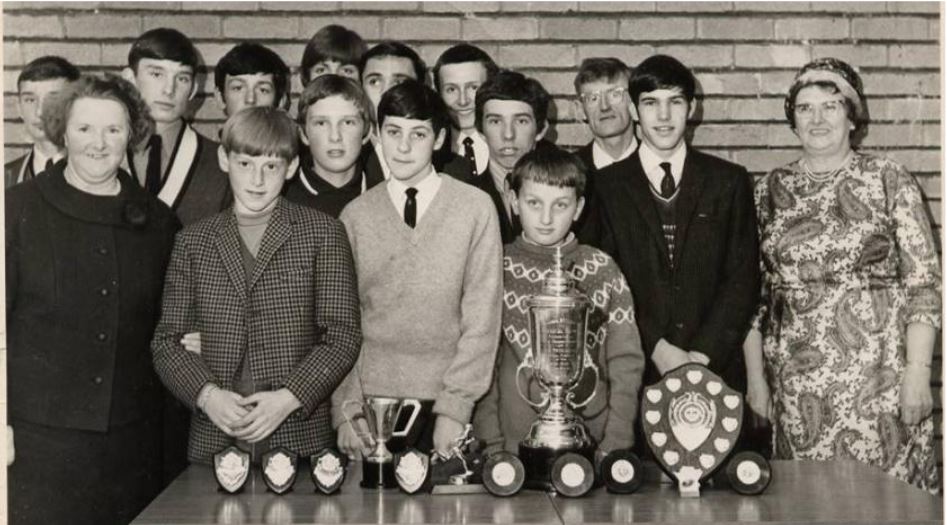
The MacFarlane Memorial Trophy, Pictured at an early running of the MacFarlane Memorial Race.
The race was first held in April 1957 with George Leggate being the surprise inaugural winner, beating the pre race favourite TD Reid into second place. The race is still held each year over the same Canderside Toll course, with the winner's name and time being inscribed on the magnificent trophy. Back in 1957 the trophy cost nearly £30.00, which was a small fortune at the time, and the quality of it makes it one the premier trophies to win in club competition to this day.
By 1960 three out of the four road races that make up the club's Road Race Championship were firmly established in the calendar. These were the Christmas Novelty, the Fairholm Ballot and the MacFarlane. Indeed, as mentioned earlier, the Ballot Team Race was staged twice a year, and at some point in the early 1960s the December version of these races was moved to October, employing what came to be known as the Turnip course.
The Turnip Road Race (so named after the year that A.B. Perrie completed his leg of the relay carrying some turnips which had fallen of the back of a farmer's trailer!) was for many years a three man relay over a 3.2 mile circuit starting and finishing just over the Millheugh Bridge on the back road to Stonehouse. In 2013 it was changed to all the runners starting at the same time, with the team places being decided by each team’s total time, thus adopting the format that has always been used in the young athletes’ race.
The successes of many club members throughout the 1950s were largely down to the work of Tom Smillie, whose enthusiasm, knowledge and experience were key factors in the period 1943 - 56. Indeed, as has often been the case before and after Tom's era, the key individuals who have kept the club going throughout its history frequently multi tasked- doing so long before the term was coined by management theorists!
Tom emigrated to Australia in early 1957, with his long and fruitful association with the club being duly recognised at a farewell dinner dance held at the Grange Hotel in Hamilton. Tom, like Davie Gracie before him, was also made an Honorary Life Member upon his departure from the club.
During the 1960s and 1970s club training became even more organized and structured - this revolution being largely the work of A.B. Perrie, who read widely and attended many coaching courses over this period. He studied the writings of the great coaches of the time (e.g. Lydiard, Cerruty) and adopted many of their principles into his training routines for the club athletes.
The club record books that were passed back to the club in late 2018 by Peter Cowan, a former club member, show that during this period the standard in track performances in events from 800 metres upwards, as well as the road and cross country performances in general, rose to such an extent that for the first time ever club athletes on a regular basis competed at or near to Scottish "open" class in middle and long distance races.
In 1960 William Morrison won the Scottish AAA half mile title (to this day he and D.K. Gracie remain the only club athletes to have won SAAA Senior individual titles) a performance which gained him an international vest that August in the Scotland v Wales match. In 1961 and 1962 he finished third in the same event, earning himself a hat trick of SAAA Championship medals. His pbs over 440yards and 880 yards were 50.7 and 1.52.2 respectively – with the later performance ranking him 4th in Scotland in 1961.
At the 1963 national cross country championships Bryce McRoberts finished in thirtieth place in the senior race and this was probably the best ever finish by a club athlete up to that time in this event. Indeed during the 1960s there were six athletes who ran under two minutes for the 880 yards; the fastest of them being Douglas McBain who, over fifty years ago, was also running close to 1m.52s on cinder tracks.
At the other end of the spectrum was the great performance of the Under 20s Men's team which won the open national cross country title at Ayr Race Course in February 1970. The team that day comprised William and lan Burns, Douglas McBain, Jim Sorbie, Jim Gilfillan, Charles Morrow, Keith Whitefield and Andrew Sandilands. W. Burns' individual performance at Ayr also earned him a place in the Scottish team that competed in the annual International Cross Country Championships held the following month in France.
This remains the greatest team performance in the club's history, although the following year Larkhall narrowly failed to retain the trophy scoring 115 points compared to Shettleston Harriers winning score of 112. Again the Burns twins were the first two counters for the team, this time backed up C Morrow and K Whitefield.
Thirty two years later, in September 2003, an under 13 Boy's Team won the bronze medal at the National Road Relay Championships held at Rouken Glen, Eastwood. Myles Hollinshead recorded the second fastest lap overall that day and he was strongly backed up by Gary Mooney and David Kane. This was only the fifth time in the club's history that a team had won medals at an open national championship.
Finally in the summer of 1974 the club took part in the SAAA’s inaugural Thistle Awards Club Competition with 10 athletes taking part in almost every track and field discipline. In what was a great team effort the two most outstanding contributors to Larkhall’s victory were Jim Egan and Walter Deans who won 5 awards each; Jim winning 4 golds and 1 silver and Walter winning 1 gold and 4 silvers.
That autumn the club was announced as the overall winner of the men’s section, beating off strong competition from clubs based all over the country. The then national coach, Frank Dick, came along to the club to do the official presentation for what was one of the SAAA’s showpiece projects. To date this is the only time that the club has won an award of this nature, making it a unique achievement in the club’s history.
Since 2014 our primary school athletes have been competing in the National Superteams Competitions organized bi-annually by Scottish Athletics. Each year one event is held indoors in January/February and one outdoors in June/July. The girls’ teams have being particularly successful in this competition having won a total of 5 medals – 1 gold, 1 silver and 3 bronze; representing a significant addition to the club’s history in team events.
Every Superteams event is well supported by the clubs throughout Scotland and the strength and depth of the competition is fantastic; therefore our medal run in this event from 2014 to 2017 was an outstanding achievement. From 2018 and 2020 the new generation of primary school club members performed well in the Superteam events without quite reaching the medal places, with the best performance being recorded by the girls who finished 4th in the 2020 indoor version of the event.
Team members over the years have included Holly Bolton, Madison Murdoch, Ellie Thomson, Chloe and Hayley Gilfillan, Codie McHolm, Cara Wilson, Emma Young, Kerry McTaggart, Chloe Hill, Kaitlyn Clark, Erin McAuley, Emma Clark, Amy Robertson and Kassidy Murdoch. Angela Young played a major role in this success, ably supported by Jimmy Cairney, Robin Lees, David McAuley and Gordon Inglis.
By the early 1970s Jimmy McCluckie had emerged as the club's premier performer over roads and cross country and he was probably the first, and so far the only man to hold the records for three of our four road races simultaneously. Jimmy ran at the very top level as a Youth and Junior, although he didn't win a full Scottish vest. However it should be remembered that the competition on the Scottish scene was exceptional at this time.
In 1973 Jim Egan (born 1960) joined the club and from the very beginning it was obvious that he was an outstanding talent. After a long apprenticeship, during the period March 1983 – August 1984 he set club records on the track and road that stand to this day, including marvellous times for the Xmas Novelty and MacFarlane Trophy Road Races. Indeed it was only an exceptional performance by Bryce McRoberts in the 1967 Turnip Relay Road Race that prevented Jim from holding that record as well.
Oddly enough his greatest performances came exactly 10 years apart: in February 1974 he won the Under 13 Boys National Cross Country title at Coatbridge, (he remains the only club member to win an "open" national cross country title) and in February 1984 he finished fifth in the Scottish Senior Men's Cross Country Championship at Irvine.
This phenomenal performance, achieved in a race of both great quality and quantity, has remained not only the best ever placing by a club athlete in this event at these championships, but also gained him selection for the Scottish team that ran in the World Cross Country Championships the following month in New York, where he performed creditably, finishing 170th in a very high calibre race; despite, like several other members of the Scottish team, being hit by a stomach bug.
Jim also won the British YMCA Senior Men’s CC Championship in 1983 at Bridgend in Wales and again in 1985 at Lanark Race Course, making him the only athlete from our club to do so. Without doubt Jim is the second greatest athlete in the club's history, with only the performances of Davie Gracie some thirty years earlier keeping him out of the number one spot.
Over the last forty years the solid coaching foundation laid down by Tom Smillie and A.B. Perrie has been built upon mainly through the work of DJ Nugent (1980s), W.J.G. Mowbray (1980 - present day), Tom McTaggart (mid 1990s to 2019) and Angela Young (2010-2022) From 2005 onwards strong coaching contributions have been made by Jimmy Cairney, James Whitelaw, Robin Lees, Ross Kidd and David McAuley. Angela Young, to the best of our knowledge, was the first female in the club’s history both to gain coaching awards and coach on a regular basis, producing both Superteams and individual athletes up to and including Under 17 level who won medals all the way through to British and international level.
Interestingly enough A.B. Perrie had a coaching comeback in the 1990s, when he trained a small but very successful group of sprinters/jumpers up to national and international standards in the U/17, U/20 and Masters age groups. Indeed one of the features of the modem day club is that we have significantly improved the performance levels on the sprinting/jumping side of the sport to a standard that only D.K. Gracie bettered in the first fifty years of the club's existence.
One of the few times that his 400m record was threatened occurred during the final of the Under 20 Men’s National Indoor League, held in February 1998 at the Kelvin Hall. That day the team, comprising Barry McTaggart, Derek Kidd, Peter Chui and Brian Smart, won the U/20 team title, with Barry recording 49.76 seconds for the 400m after already racing hard over 60m and 200m. This team achievement probably is the second greatest one in the club's history, in terms of performance at an open competition.
In 1988 Steven Shanks was a bronze medal winner in the 100m and a silver medal winner in the 200m at the Scottish U/20 Men's Track Championships. That same year he won an international vest representing Scotland against Northern Ireland, winning his 200m race and being part of the winning 4x100m relay team. Steven was not only a winner at district, inter district and national level, both indoors and out, but also set club records at 60m, 100m, and 200m. His 60m record stands to this day, although his 100m and 200m records were finally surpassed in 2021.
Kevin Woods, although primarily an 800m runner, won the national indoor U/20 Men's 400m title in 1991 in 50.41seconds. He was also part of the 4x200m team that finished second in the senior indoor relay championships in February 1991.
The other members of the silver medal winning quartet were David Gilmour, Steven Shanks, and Scott Ferguson. Kevin’s best time for 800 of 1.54.72, recorded in June 1994 at the SAAA Senior Championships at Meadowbank, almost certainly ranks him fourth in the club behind Derek Leitch’s club record of 1.50.7, William Morrison’s 1.52.2 and Douglas McBain’s 1.52/53.
Twenty seven years later, in February 2018, the men’s relay performance was matched at the SAIAG Relay Championships when an Under 13 Girls 4x200m Team, comprising Chloe Gilfillan, Chloe Hill, Codie McHolm and Madison Murdoch, finished second behind the Ayr Seaforth quartet in a thrilling final, missing out on the gold medal by an agonising 7/100ths of a second. The girls had previously won their heat and semi-final in1.57.5 and 1.56.14 respectively, before recording the superb time of 1.54.59 in the final, a performance which ranked the team second in the Scottish all time lists for this event.
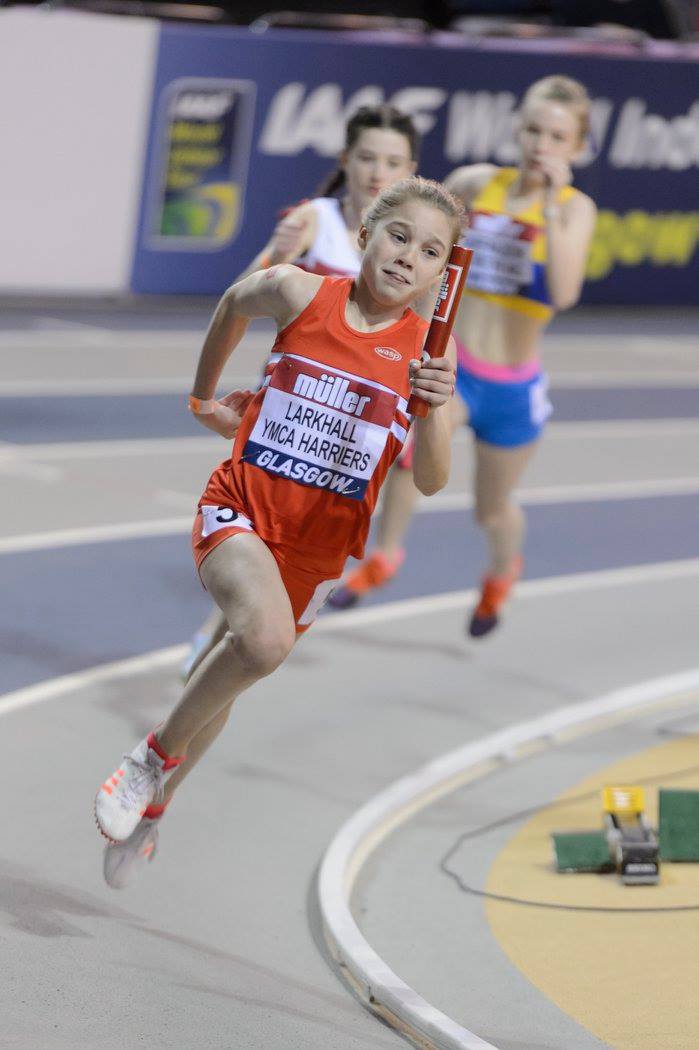
Maddison Murdoch Scottish Athletics Age Group Relays February 2018 (C) Bobby Gavin
In February 2019 at the SAIAG Relay championships our Under 15 Girl’s 4x200m Team - Caitlyn Foster, Codie McHolm, Sophie Evans and Madison Murdoch – finished fourth in the final, recording a new outright club record of 1.49.14. At the same event our Under 15 Boys won the silver medals in the final of the 4x200. The team was Dean Hill, Rhys Hogg, Cameron Martin and Dean Patterson.
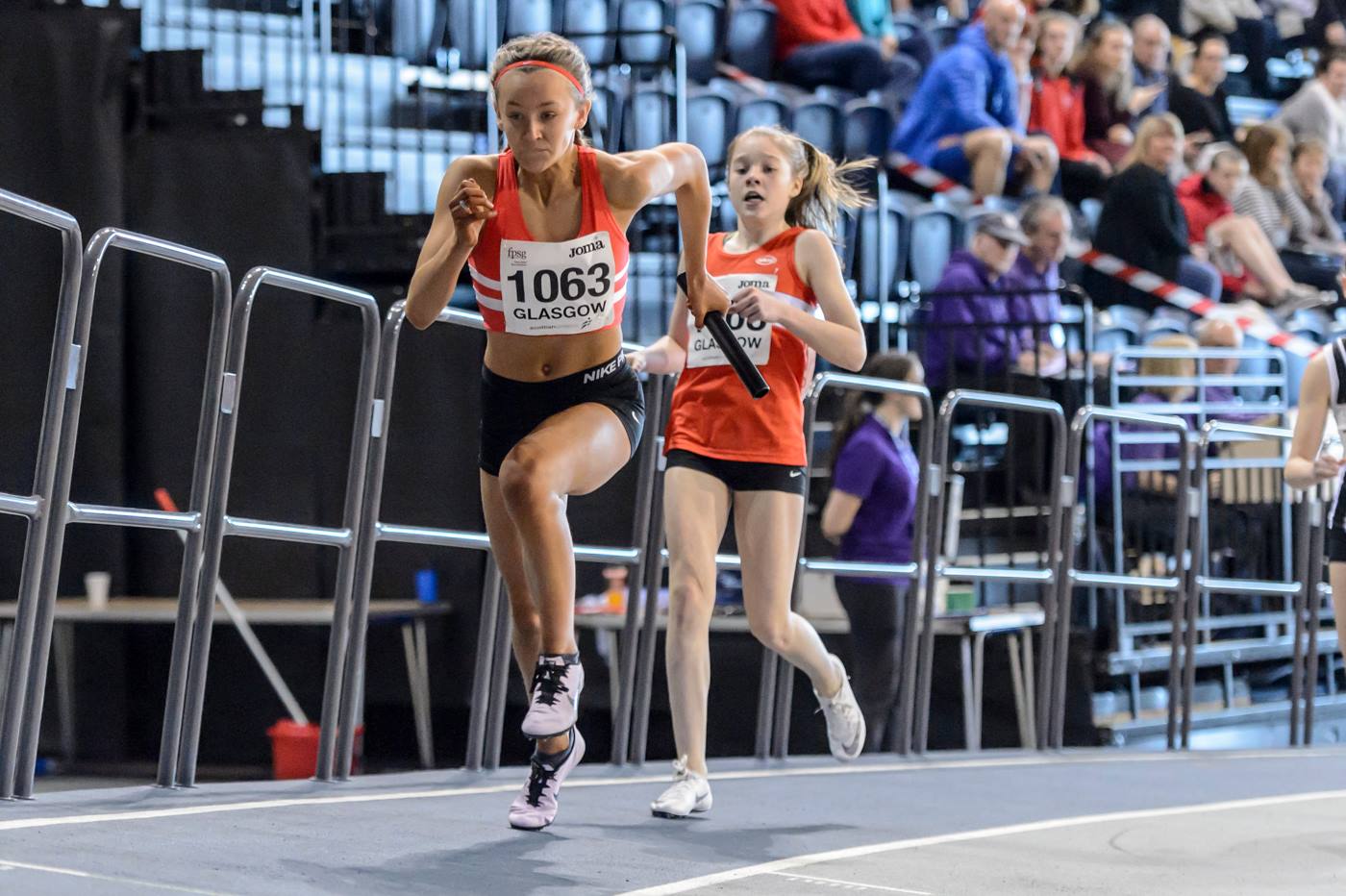
SAIAG Relay Championships 2019 (C) Bobby Gavin

Cameron Martin, Dean Hill, Rhys Hogg, Dean Patterson, 2019 SAIAG Relay Championships, Silver Medal Team 4x200m
Three months later at the Lanarkshire AAA Track Relays an Under 15 Girl’s Team – Madison Murdoch, Caitlyn Foster, Sophie Evans, and Jade Gray – set an outright club women’s record of 53.42 en route to winning 4x100. In September 2019 at the SAAG Outdoor Relay Championships, the Under 15 Boy’s Team – Dean Hill, Kyle Weir, Blair McAuley and Dean Patterson – took the bronze medals in the 4x300 in a time of 2.49.40. Finally in February 2020 at the SAIAG relay championships the under 15 Boy’s team – Dean Hill, Anthony Cuthbert, Kyle Weir and Dean Paterson - won the bronze medals in the 4@200m relay despite Anthony not cutting in at the break point in the second leg which resulted in him running approximately 230m!
Outdoors in the mid 1990s Andy Sandilands was a medallist at both 3km and 5km at district, inter district and Scottish schools level. He also won international vests for the Scottish schools for track and cross country. Barry McTaggart had an excellent career at U/17 and U/20 level, being a quadruple gold medallist at district level (all won on the same day), a double gold medallist at West district level, a bronze medallist at U/20 National level in the 200m, a silver medallist at the indoor Scottish schools and a double silver medallist at the schools' outdoor track championships in 1996 in the long jump and triple jump.
This last performance won him a schools international vest for the meeting in Wales that year, where he performed outstandingly in the triple jump to win the silver medal by soaring out to 13.14m - a club record at the time. Uniquely, in 1996 Barry ranked in the top ten in Scotland at U/17 level in no less than seven events - 60m, 100m, 200m, 400m, LJ, TJ, and HJ.
Between 2012 and 2018 three athletes emerged, Alexander Young, Ross Lyttle and David Lees, who had the potential to threaten the long standing senior sprints, middle distance and field event records respectively. Alexander in particular, during his first spell in the club, was a national level performer at 60m, 100m and 200m, winning medals and titles at U/13, U/14 and U/15 and U/17 level both indoors and out. In February 2014 at the SAIAG Championships he won gold in the Under 14 Boy’s 60 and silver in the 200m. In 2015 he finished a great year by winning the Scottish Age Group U/15 200m title at Grangemouth in August, having already won over 100m at the Scottish Schools two months earlier.
During the outdoor season he was unbeaten over either 100m or 200m, an achievement probably never completed before by one of our club members at any level, with the possible exception of DK Gracie. Alexander continued to win medals and titles at national level – a double gold medallist in February 2016 at the Scottish Secondary Schools Indoor Championships, a bronze medallist six months later at the Scottish Athletics Age Group Championships (SAAGC) in the Under 17 200m, bronze and silver medallist in the 60m and 200m respectively at the indoor SAAGC in February 2017 and a semi finalist over 60m and 200m later that month at the AAAs in Birmingham.
In July 2017, following his double silver medal winning performances in the 100m and 200m at the Scottish Secondary School’s Championships he was selected for the Secondary Schools International held in Dublin thereby joining a very exclusive band of club members who have achieved this distinction. Unfortunately, the recurrence of a hamstring injury at the Scottish Age Group Championships the following month almost certainly robbed him of the 100m title and a medal in the 200m.However despite this setback, he bounced back strongly early in 2018 to make the final of the New Year’s 110 Handicap Sprint at Musselburgh Race Course becoming the first athlete in the club’s history to do so.
The following month he picked up a gold medal as part of the Giffnock Under 20 Men’s 4x200m quartet that took the national indoor title. He quickly followed this up with another double medal winning performance at the Scottish Schools’ Indoor Track Championships, finishing 3rd in the over 16s 200m and 2nd in the 60m. Unfortunately, his hamstrings let him down again at the SAIAGC in March whilst attempting to medal in his first year as an under 20. The resultant injury plagued him for the rest of 2018 which meant that the senior men’s club records lay tantalizingly just beyond his grasp. After a break from the club he re-joined the Harriers from September 2019 March 2022 but, unfortunately he never managed to fulfil the great promise he showed as a teenager.
Alexander was part of the excellent sprint group developed by Tom McTaggart between 2009 and 2019. Sol Stewart was also a member of Tom’s group in his short career with the Harriers. Starting in August 2015 he picked up a bronze medal in the U/15 100m at the SAAGC. At the Scottish Secondary Schools Championships in June 2016, he won gold in the 100m and silver in the 200m as an U/14 Boy. Two months later he won the bronze medal in the U/15s 200m at the Scottish Age Group Championships. In February 2017 at the indoor SAAGC he won gold in the Under 15 Boys 200m while Madison Murdoch, another youngster with great potential, won her first individual medal at national level, claiming silver in the under 13 Girls 200m at the same competition. A couple of weeks later Sol took the bronze medal in the Under 15 Boys 200 at the UK Indoor Age Group Championships, thus becoming our first athlete ever to medal at this competition.
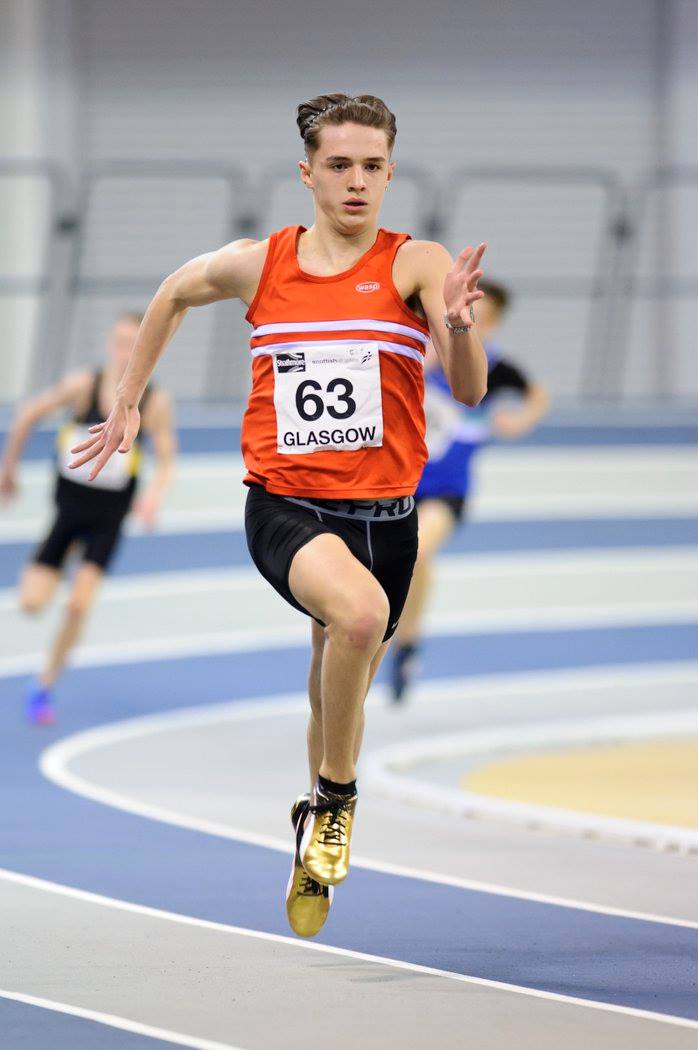
Sol Stewart Age Group Championships February 2017 (C) Bobby Gavin
Ross Lyttle first showed his potential at national level competition in February 2014 when he took the silver in the U/16 1500 at the Scottish Age Group Indoor Championships. He followed this up in 2015 by finishing in an excellent 5th place in the final of the Scottish Schools 800m in June and narrowly missing the U/17 final at the Scottish Age Group Championships in late August. Two weeks later he became the first male athlete in nearly 20 years to run sub 2 minutes for 800m when he clocked a 1.59.6 at the Club Championships at Wishaw. Unfortunately he missed most of the 2016 outdoor track season through injury after having performed well indoors during the previous winter.
He made a strong comeback in 2017, winning the LAAA Senior Men’s 400 and 800 titles, winning the West District Under 20 800m title and reaching the finals of both the Scottish Schools and Scottish Age Group Championship at Under 20 level. He finished the season with pbs of 50.75 and 1.57.65 in the 400m and 800m respectively - these performances being the best recorded in the club in nearly 20 years.
In September 2017 Ross started his Dentistry course at Newcastle University which greatly curtailed his training programme. However in a very short training and racing window lasting from early June to early September 2018 again he came back strongly to record a new pb of 1.56.7 in the Senior heats of the SAGC 800m, qualifying for the final in the process, before retaining the Senior Men’s 400m title at the Lanarkshire AAA Track Championships. Subsequent to 2018 his training and racing were sporadic, resulting in no improvement in his track performances recorded as a teenager.
In 2014 David Lees finished 4th in the javelin at both the Scottish Schools and Scottish Age Group Championships. The following year he was selected for the Celtic Games and at the Scottish Age Group Championships improved his javelin PB from 42.60m to 47.82m. In 2017 he took second place in the Javelin at the Scottish Secondary Schools Championships, throwing the senior 800gr javelin out to 50.11m. This performance obliterated the previous club record of 34.78m which had stood for more than 25 years. David is one of the very few athletes in the club’s history to make an impact at national level in throwing events. In 2018 he moved on to Team Glasgow to try and improve his competition opportunities but, like Alexander and Ross, to date he has not performed at the same level as he did as a teenager.
In April 2013 Thomas Watson finished 9th overall in the P7 race at the Scottish Primary Schools’ CC Championships, becoming the first male athlete to make the top ten since Myles Hollinshead won the P7 race exactly 10 years earlier. From then until December 2018 Thomas performed very successfully at Lanarkshire level on the track, roads and cross country; indeed his win in the Under 17 Men’s race at the Lanarkshire CC Championships in late November 2018 was one of the finest performances by an athlete in this age group in more than 20 years. However, he never managed to replicate this form at either inter district or national level.
In February 2004 Myles Hollinshead finished 9th at the Scottish CC Championships in the U/13 Boys Race. This was the first top ten placing in this race by a club athlete since Jim Egan’s victory in 1974. The following month, after picking up the silver medal in the U/13 Boys 800m at the Scottish Indoor Track Championships, he recorded a great win in the Group D race at the Scottish Secondary Schools’ CC Championships. To date he remains our only winner at this event.
A few months later he left the club to join Giffnock North AAC. In April 2017 Cooper McHolm finished 4th in the Primary 6 Boy’s Race at the Scottish Schools PS Cross Country Championships at Kirkcaldy, becoming only our third top ten finisher in the history of the event.
2018 saw the emergence of Dean Patterson, another exciting young sprinting talent, in the Under 13 Boy’s age group. In March he won the silver medal in the 200m at the SAIAGC, recording a time that placed him 6th in the UK Power of Ten rankings at the end of the indoor season. At the outdoor age groups in August he was a double gold medallist in the 100m and 200m which is the first time this has been done by a club member at open national level in the Under 13 age group.
At the end of the outdoor track season he was ranked 20th in the UK over 200m. Dean’s fine form continued throughout 2019, winning bronze medals over 200m at both the indoor and outdoor SA Age Group Championships, bronze at the Scottish Schools’ Indoor Championships, double gold over 100m and 200m at the Scottish Schools’ Outdoor Championships in Group D, double bronze over 100m and 200m at the West District Championships, and double gold over 100m and 200m at the Lanarkshire AAA Championships. Although only a first year in the Under 15 age group he finished up as the 3rd and 6th ranked athlete in Scotland over 200m and 100m respectively.
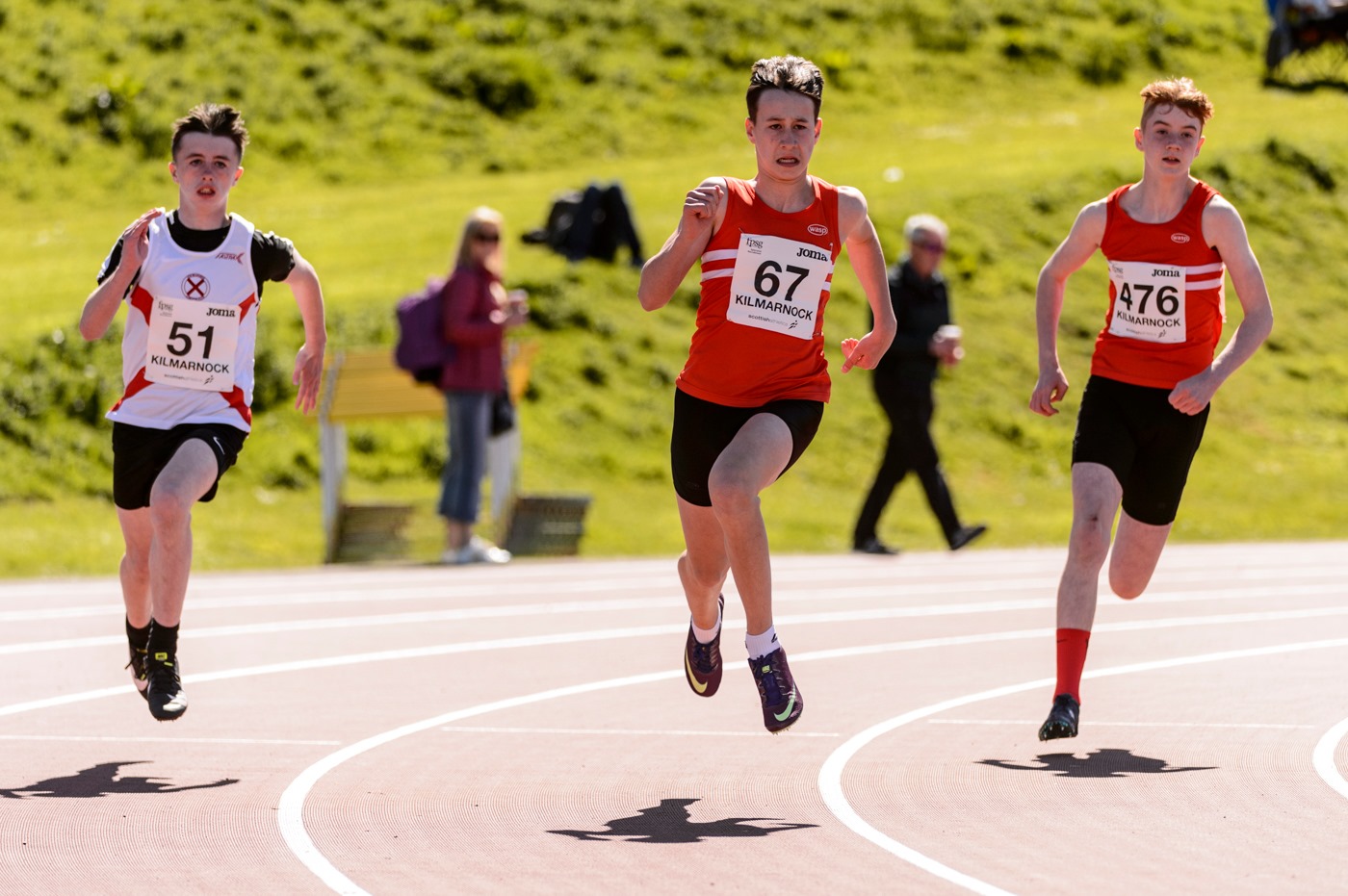
Dean Patterson & Cameron Martin. Scottish Athletics West Districts 2019 (C) Bobby Gavin
Although his second year of racing in the under 15 age group was severely curtailed outdoors in 2020 by the Covid-19 pandemic Dean Patterson performed outstandingly during the 2020 indoor season. Having just turned 14 he won the under 16 200m title at the Scottish Schools Championships, setting a new under 15 Scottish age group record in the process. His time of 22.67 seconds also won him the trophy for the most outstanding performance at the championships.
He also won double gold at the SAIAGC over 60m and 200m and at the English IAGC in Sheffield he finished 5th in the 60m and first in the 200m. His 200m time of 22.58 was another Scottish Indoor record. This was the first time that a club athlete had won a title at UK level indoors in the club’s history. Indeed at the end of the indoor season he was ranked 7th in the UK at 60m and 1st in the UK at 200m. Although outdoors he was limited to only two 200m races in late August/ early September, in the second of them at an open graded meeting in Manchester he ran 22.33 seconds to set a new outdoor Scottish record for an under 15 Boy.
If he had been able to compete in a full outdoor season Steven Shank’s club record of 22.00 seconds would have been seriously threatened and Steven’s 10.85 seconds 100m record may well have come into play as well, given the fact that Dean recorded 11.13 in the second of only two outings over the distance. At the end of the outdoor 2020 season Dean was top of the Under 15 Boy’s rankings in the UK at both 100 and 200m. This represented another first in the club’s history. Also by the end of the 2020 outdoor season Dean Hill, who had made his first impression at national level the previous year when finishing third in the Group D 800m final at the Scottish Schools’ Outdoor Championships, ranked 4th indoors and 7th outdoors in Scotland over 800m as an under 15 Boy, lowering his personal best to 2.08.46 in the process.
Despite lowering his 800 pb to 2.03.30 by the summer of 2022 that July Dean switched to the 400 and over a seven week period, with very little background in one lap racing, he reached the Under 17 age group final, the under 20 age group final and won the under 17 200 and 400 at the Lanarkshire Championships in pbs of 23.91 and 51.30 respectively. With these performances he has shown that in the coming year he has the potential to become the first athlete to go sub 50 for 400m since Barry McTaggart back in 1996.
Peter McGuigan finished the year ranked 4th in Scotland and 14th in the UK over 800 as an Under 13 Boy. His indoor time of 2.20.03 earned him the bronze medal at the SAIAGC in February. Like Dean Patterson, their competition opportunities were severely curtailed by the Covid 19 pandemic. Unfortunately for athletics Peter decided to choose football as his main sport in 2021.
In 2021 the Covid Pandemic wiped out the indoor season but from April onwards the outdoor season steadily returned to something close to normal. Dean Patterson took full advantage of the increased competition opportunities at the English Age Group Championships on August 7th to finish second in the Under 17 men’s 100m in a legal 10.77. This was a new club record, which surpassed the previous mark of 10.85 set by Steven Shanks more than thirty year earlier.
Just over a week later at Grangemouth he won the Scottish under 17 men’s 200m in a windy 21.87, after having been disqualified the previous day in the 100m for false starting. However a fortnight after that he set a new club record of 21.75 en route to winning silver in the under 20 championships at Aberdeen – the next day he also won silver in the Under 20s 100m. He broke the previous record by 0.25 seconds, which had also been held by Steven Shanks for more than 30 years.
Dean finished off a superb season by further lowering the 200m record to 21.63 at the Schools’ International meeting held in Derby on September 25th. That day he finished 4th in the 100m and first in the 200m. These performances were all the more remarkable given the fact that he achieved them as a first year under 17 Man and, in addition to topping the Scottish rankings over 100 and 200, he also finished third and first respectively over the 100 and 200 in the UK rankings.
Finally, for the second year running, he created a piece of club history by becoming the first ever member to top the UK Under 17 Men’s rankings in any event. Unfortunately, due to a change in his training circumstances, Dean had to resign from the club at the end of September 2021. Hopefully he will go on to achieve much more in our sport but if he does both Tom McTaggart and Angela Young will always deserve great credit for the work they did with him during his time at the club.
In the late 1960s and early 1970s a small band of successful female athletes were coached by David Gebbie. Included in this group were Sandra Dunn, Sandra Barclay, Nancy McGill, Linda Hamilton and Margaret Brown. They competed successfully over a range of distances on the track, roads and cross country. Perhaps the two finest achievements were recorded by Sandra Dunn when, in February 1972 at Dunfermline she finished 11th in the senior women’s Scottish CC Championships, one place and 12 seconds ahead of Margaret Brown.
This is the highest ever finish to date in this event by a female member of the club. Moreover, that day our ladies team finished second in the team event, with Sandra Barclay and Nancy McGill providing strong back up to Dunn and Brown by finishing 20th and 26th respectively. Again this is the best ever finish recorded by a Harrier’s female team at these championships.
Two months later Sandra Dunn took part in the McFarlane Road Race recording a time of 30 minutes and 20 seconds, which remains the female record for the event more than 50 years later. From the late 1980s our best female athletes have also recorded some great performances at inter district, national and schools international level.
In 1993 Laura Fitzpatrick became the first female athlete to win a medal at the West District Track Championships, either indoors or out, since the start of the modem ladies section in 1983, when she took the silver medal at that year’s outdoor event in the U/13 Girls 200m. In February 1995 Jill Shearer won the U/13 Girls 800 m indoor titles at both the West District and National Championships.
The achievements of Christina Whitelaw at under 15, under 17 and under 20 levels were particularly noteworthy, having been an athlete who competed well against her contemporaries on the road, cross country and track on the national stage. At club level she holds the senior women’s records for 800, 1500, 2000 and 3000, plus 3 of the 4 road race records. To date she’s only one of six female athletes to medal at the Scottish Secondary Schools 'Outdoor track championships, three of whom won their schools' international vest in the process- Christina in 2003, Madison Murdoch in 2021 and 2022 and Chloe Hill also in 2022.
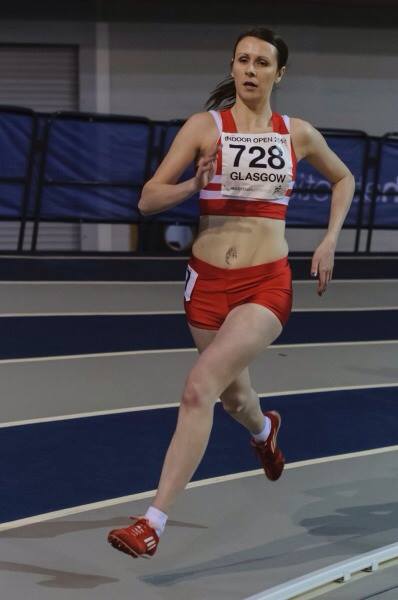
Christina Whitelaw- Collins, National Indoor Open, Glasgow 2014.
In February 2005 Christina won the U/20 women’s national indoor 1500m title. Indeed she was one of the few female athletes to perform consistently at a top level since the strong performances of the small group of female runners in the early 1970s mentioned earlier. In April 2006 Emma Walker finished 12th overall at the Scottish Primary Schools CC Championships, a performance which remains the best one so far by a female at this event.
Over the years three young female athletes have been selected to run in the Scottish team in the London mini marathon, an event held in conjunction with the London Marathon - namely Christina Whitelaw, Jodie Frame, and Sarah Archibald. Jodie and Christina also represented the West of Scotland in the SCCU Inter District Cross Country Races.
Another female performance of note in "open" competition was that of the young athletes who finished fourth in the National Cross Country Relay Championships held at Cumbernauld in October 2001, (the team members were Harriet Hill, Christina Whitelaw, and Lesley Haig).
August 2011 saw Morven Miller winning a gold medal as a member of Law’s U/14 girls’ 3 x 800m relay team at the Scottish Champs.
The following year the first female member of the club ran a marathon when Fiona Mowbray completed the London event on Sunday 22nd April in 4 hours and 53 minutes. Then in May 2014 Fiona reduced her record to 4 hours and 46 minutes when competing in the Edinburgh Marathon. An interesting footnote to Fiona’s performances is that she literally followed in my footsteps, as I was the first male member of the club to run the distance when I completed the London Marathon in March 1981, recording a time of 2 hours and 56 minutes.
At the other end of the competition spectrum, 2012 also saw the arrival in the club of Cara Jay Murdoch who, over the next 5 years completely re-wrote the female club records over 60, 100, 200, 300 and 400m, despite only turning 18 in September 2015. Cara Jay won medals, both indoors and out, in competitions up to and including the Scottish Age Group Championships and the Scottish Schools Championships.
For example between January and August 2012 she won medals indoors and outdoors at district, inter district and national level, both at Scottish Age Group and Scottish Schools Championships. Moreover in June 2012 she and Emma Henderson won bronze as members of Law’s U/16 girls’ 4 x100m team at the Scottish Championships.
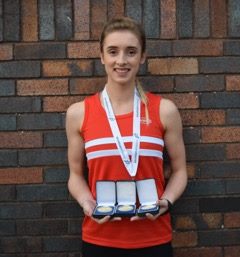
Cara Jay Murdoch, Age Group Champs, Grangemouth, 21st August 2016
In 2013 she won the SA U/18 100m title at Aberdeen and also finished second in the 200m on the same day. In February 2014 she won silver in the 60m and bronze in the 200 at the SA Under 18 age group Championships and in the Under 14 Girl’s 200 Kirsten Shanks took the bronze medal. In both 2013 and 2014 Cara Jay was selected for the Celtic Games on the basis of her performances at national championships, and in 2014 she was also picked to run in the 200m and 4 x 100m as part of the Scottish Select Team competing against University Teams from the Home Countries.
During this great spell of success she became only the second female club athlete to medal at the Secondary Schools’ Track Championships. Finally, in April 2016 Cara Jay won gold in 100m and 200m at the University Champs which were the last medals she won at national level while still a club member.
In 2018 two of our younger female members picked up four bronze medals at national championship level in the Under 13 Age Group, with M Murdoch and C McHolm claiming a brace apiece. Madison won hers in the 60m indoors and the 200m outdoors while Codie claimed her indoor and outdoor medals over 800m. Moreover at the Lanarkshire Secondary Schools Championships in June, Codie ran 1.41.5 for 600m – rounded up by 0.4 seconds from the official time – which knocked more than 5 seconds off the existing club record and placed her in an unofficial 3rd place in the UK rankings for this event.
Unfortunately her time couldn’t be put forward for official recognition as there were no qualified timekeepers present that day. The previous month she had shown her potential across a range of events when she won the West District HJ title setting a club record height of 1.43m. As the 2018 track season came to a close we had one of our best ever days at the LAAA’s Track Championship with club members winning 15 medals, including 7 titles, over a variety of age groups and events.
As we moved into late autumn and early winter excellent individual and team performances were recorded at both the LAAA’s Road Relay and Cross Country Championships. At the Road Relays the Under 13 Girls Team – Chloe Hill, Chloe Gilfillan, Codie McHolm - were outstanding winners and at the Cross Country Champs we picked up two sets of team medals: silver and bronze in the Under 13 Girl’s and Under 15 Boy’s events respectively, and three individual medals, gold (Thomas Watson), silver (Dean Hill) and bronze (Chloe Hill) in the U/17 Men’s, Under 13 Boys and Under 13 Girls races respectively.
2019 heralded the emergence Kaitlyn Clark in the long jump in the Under 13 Girls age group. She won both the Scottish Age Groups National Indoor and Outdoor titles in this discipline in February and August respectively, becoming the first ever club member to complete such a double in any field event at this level. She also finished 4th in the Scottish Schools’ Outdoor Championships, was a triple gold medallist at the Lanarkshire AAAs in the 100m/200m and long jump, and a silver and bronze medallist in the 200m and 100m respectively at the West District Championships.
